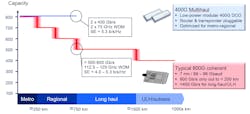High-performance pluggable coherent optics: Introducing 400G Multihaul
The introduction of fifth-generation coherent optics has brought two exciting developments to the world of optical transport. At one end of the spectrum, power-optimized digital coherent optics (DCOs) such as 400ZR/ZR+ provide pluggability that enables network operators to equip coherent optics directly in 400 Gigabit Ethernet (GbE) router ports. At the other end, performance-optimized coherent optics operating at 90+ Gbaud enable 400-Gbps transport over virtually any distance in long-haul networks, and even higher capacities over metro and regional distances. Sitting at the intersection of these two implementations is 400G Multihaul, which provides 400-Gbps coherent capacity in a pluggable form factor. Used in routers and optical transport systems, such devices provide enhanced functionality and the capacity/reach performance needed for use across a range of metro and regional network applications (Figure 1).
400ZR/ZR+ versus 400G Multihaul CFP2
400G Multihaul DCOs leverage several key attributes to deliver the most cost-effective transport across a broad range of network applications and use cases. First, 400G Multihaul coherent transceivers can be implemented as pluggable DCOs in the CFP2 form factor, which means they can be deployed in 400G-capable router ports and optical transport systems. This use of the CFP2 form factor in turn enables a host of service-oriented and performance-optimizing features that 400ZR/ZR+ DCOs cannot support.
The path to 400G Multihaul DCOs starts with continued advancements in designing coherent digital signal processors (DSPs) that are optimized for low power consumption. The first step to achieving this is to leverage Moore’s Law in the latest generation of 7-nm silicon CMOS node technology to reduce power per bit compared to prior DSP generations and scale the baud rate to 60–64 Gbaud. These cornerstone advances are combined with the use of energy-efficient forward error correction (FEC) algorithms with high net coding gain and high-order modulations such as 16QAM to enable transmission of 400 Gbps per carrier over distances that were previously out of reach for even high-performance coherent optics.
Together, these advances have spawned a new category of coherent optics that includes 400ZR and 400ZR+ pluggable DCOs. The key benefit of 400ZR and 400ZR+ is that they can be implemented in the same router-pluggable form factors, including QSFP-DD or OSFP, as 400GbE short-reach grey optics, such as DR4, FR4, and LR4. This means that operators can integrate 400G coherent WDM capabilities in routers, nominally without any trade-off in router interface faceplate density.
With 400ZR, operators can support IP-optical integration in applications such as point-to-point data center interconnect (DCI) for up to 64 x 400G channels over distances up to 120 km. Using 400ZR+, they can support even longer DCI links and efficient single-hop IP hub-and-spoke topologies in metro networks. The use of 8QAM or QPSK modulations makes longer reaches possible, albeit with a reduction in capacity to 300G, 200G, or 100G per wavelength.
However, the practical reality is that the power consumption of these pluggable transceivers, typically 17.5 W for 400ZR and up to 20 W for 400ZR+, exceeds the defined power rating of 14.5 W for QSFP-DD ports. While this will not prevent operators from using 400ZR and 400ZR+ for their intended applications, the need to carefully limit power consumption imposes some important compromises. First, it limits DSP operating modes to a limited set of features, such as supporting only Ethernet client inputs. Second, it limits optical launch power to –10 dBm and lowers the optical signal-to-noise ratio (OSNR). Finally, it requires routers to be designed with the ability to cool 20 W per port or otherwise risk limiting how many ports – or which ports – can be equipped with 400ZR/ZR+ DCOs.
So while 400ZR/ZR+ DCOs enable important network cost savings by allowing IP-optical integration in access, DCI, and metro aggregation applications, they offer limited performance and usefulness in metro-regional IP core applications. In addition, 400ZR/ZR+ DCOs do not provide some of the key features required for optical transport-oriented applications, such as support for OTN clients and optical layer encryption.
An ideal solution would be a DCO transceiver that is pluggable into both routers and optical transport systems, allows enhanced capacity/reach performance for use across a broad range of applications, and supports the features needed for both IP-optical and optical transport applications.
Benefits of 400G Multihaul DCOs
400G Multihaul DCOs balance these competing sets of requirements to give network operators another option for optimizing their IP and optical networks with the right coherent transport solution. The term “Multihaul” explicitly derives from this balance, which allows operators to use 400G Multihaul DCOs across a broad range of topologies and applications in metro, regional, and national networks while supporting a range of service features.
A 400G Multihaul DCO (Figure 2) leverages the pluggable CFP2 form-factor to increase the allowable power limits of the transceiver to provide enhanced capacity/reach performance and a broader range of networking features. Pluggability allows operators to use these DCOs in routers designed to accept CFP2 transceivers, or optical transport platforms such as compact modular systems, transponders and muxponders, or packet OTN (P-OTN) switches.
These features increase the overall capacity/reach performance of 400G Multihaul DCOs, which means they can be used in regional network applications spanning hundreds of kilometers, in 75-GHz-spaced WDM networks. This also expands their use with ROADMs to enable efficient single-hop 400G connections between router nodes in metro networks. Such features also provide compatibility with colorless/flexible grid and colorless/directionless/contentionless/flexible grid (CDC-F) ROADMs in more complex optical transport network topologies.
Examples of the enhanced capacity/reach performance of 400G Multihaul DCOs were presented in technical papers at the 2021 Optical Fiber Communications conference. For example, a paper from NeoPhotonics showcased late-breaking results of transmission at 400-Gbps data rates over a distance of 1,500 km in a 75-GHz-spaced DWDM network, while, Nokia presented results showing transmission of 20.8 Tb/s over 1,200 km of G.654E fiber with 400G Multihaul modules operating at 400 Gbps.
Use of 400G Multihaul DCOs
The capacity-reach performance of 400G Multihaul DCOs enables operators to use them in real-world metro and regional links in a more cost- and power-efficient manner than performance-optimized “800G coherent” optics operating at 90+ Gbaud, often referred to as “800G coherent.” These 800G optics typically operate at 800 Gbps per carrier only at metro distances up to 200–300 km. Longer distances with these optics are then achieved by dialing down the capacity of the coherent carrier to 700G, 600G, and so on.
For metro-regional applications, 400G Multihaul DCOs can thus provide equivalent or greater spectral efficiency compared to 90+ Gbaud transponders that have a nominal capacity of 800G. They can also consume less power per bit compared to system-mounted high-performance coherent optics (Figure 3) and provide the benefits of a pluggable “pay-as-you-grow” deployment model.
Another benefit of the additional capacity/reach capabilities of 400G Multihaul DCOs is the ability to support a broader range of IP/optical network use cases. When used in suitably designed routers, 400G Multihaul DCOs enable direct single-hop router-to-router connections across multiple intermediate nodes in ROADM-based WDM networks. This ability avoids unnecessary transits through intermediate routers for large end-to-end packet flows and eliminates the cost, power, and fabric-exhaust inefficiencies of hop-by-hop routing.
By using 400G Multihaul DCOs for IP/optical integration, network operators can create efficient leaf–spine architectures for hub-and-spoke traffic aggregation in large, multi-node metro and regional rings, cable distributed access architectures (DAAs), and packet core architectures. They can also support any-to-any scaling of IP networks in metro and regional core networks.
Another important feature of typical 400G Multihaul DCOs is their ability to leverage a wide range of DSP operating modes to support more transport-centric applications. For example, versions of 400G Multihaul DCOs can support multi-vendor interoperability based on standards such as OpenZR+ and OpenROADM. Other options include implementation of vendor-specific FEC modes that permit interoperability with both prior and current generations of coherent optics.
In addition, 400G Multihaul DCOs support features such as OTN encapsulation of OTU4 and OTUCn clients, along with 100/400GbE clients for use in enabling end-to-end OTN transport services in optical transport networks. They can also support value-added features such as AES256 encryption for network operators that need the highest level of security within the optical data plane.
By providing options for enhanced capacity/reach and features required for optical transport services in a pluggable DCO form factor, 400G Multihaul DCOs give network operators more ways to optimize their coherent transport capabilities across different network use cases. With the right combination of 400ZR/ZR+ and 400G Multihaul pluggable DCOs and 90+ Gbaud high-performance coherent optics, network operators can cost-effectively enable 400G everywhere, from access, DCI, and small metro rings, through metro-regional core networks, and across long-haul and subsea distances.
Serge Melle is director, optical product marketing, at Nokia. He previously led the company’s North American sales enablement for IP/optical networks. Prior to joining Nokia, Melle worked at Infinera in product and solutions marketing and business development. Prior to Infinera, Melle worked at Nortel Networks where he was responsible for solutions marketing and business development. Earlier, he was with Pirelli Telecom Systems where he was involved in the implementation of the industry’s first WDM network deployments.
About the Author
Serge Melle
Director, Optical Product Marketing, Nokia
Serge Melle is director, optical product marketing, at Nokia.



